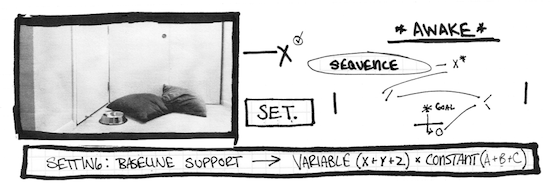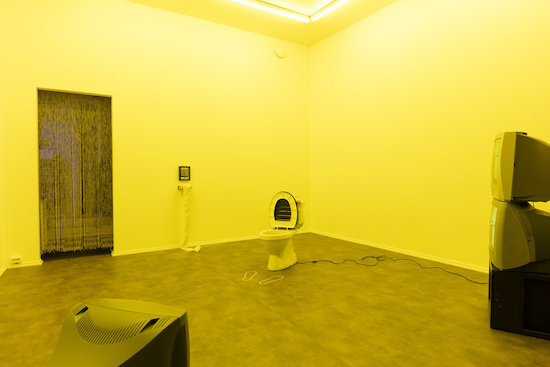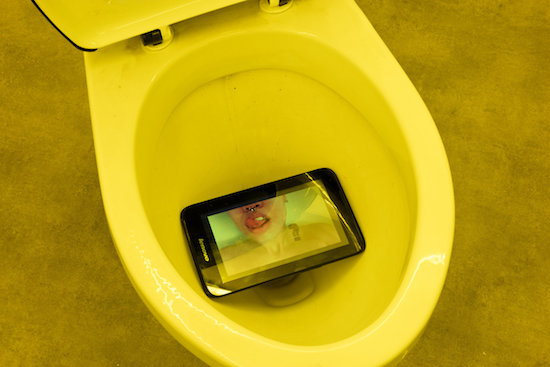Shawné Michaelain Holloway is an American artist currently based in Chicago and New York. She works across digital and physical platforms exploring power, perception and participation – often through the use of BDSM themes and aesthetics.
Her work encourages participation with the viewer, to varying degrees. It encourages a dialogue on the power dynamics at play within the act of viewership, the work itself and the communities or acts within it. The use of BDSM aesthetics emphasises consideration of the power dynamics that we are party to on a daily basis. The stark, often stressful imagery is mostly self shot and personal, although also found by call out or appropriation, we see the allegories between this exchange and the exchange with the viewer.
Gallery shows like ‘Sub Not Slave’, an installation at Sorbus in which the space is transformed to echo a sex club toilet, provide a unique interactive space for the viewer. In this instance, a video piece was shown from the inside of a toilet bowl, in which the viewer must place their head to watch. Her works allow for the observation of human beings, as they subjugate themselves in favour of experience. It could be argued that this subjugation is no different from sitting through a traffic jam to make an appointment – submission is considered as a state of being. If there is a submissive party, there must be a dominant one. Herein we find the dynamics explored in much of Holloway’s work.
In more recent pieces such as the ongoing twenty part project entitled ‘The Chamber Series’ we see new territory explored within the same aesthetics. Positioned in her own words as ‘A portfolio of scores, inspired by graphic notation, for classical music that illustrates a series of BDSM acts’ accompanied by a partner publication entitled ‘The Companion’. A great deal of consideration is given to the disemmination of information. The way that Holloway’s work reaches the viewer is also being stretched, altered as is seen necessary. Once considered an Internet artist, she is exploring the implication of distributing information through print publication, as well as the power dynamics at play within it.

I’m interested in the fact that you’re making art which requires a degree of sacrifice to view. Not only does it feature BDSM aesthetics, if I want to view it, I have to subjugate myself in some way. Could you comment on this decision?
Shawné Michaelain Holloway: I try to make that the case with every work of art, I think I started doing that because I didn’t understand how to take my work and externalise it from the internet. The first time I had done that was ‘Daughter of the Cage‘. I had four solo shows that year, it was dumb. It was too much but what it did do was teach me how to put things in a space. When I go to see contemporary art, unless its a subject that I’m super interested in, I am kind of bored. It feels like studying. I go to these exhibitions for the sake of studying because it’s always good to take inspiration from different corners of the universe – You can’t stay in your BDSM hole forever. I wanted there to be some kind of take-away, or activity. I also feel like we often labour over trying to impress a viewer or to give them something – I don’t want to impress anybody, I want to interact with them. I want it to be an equal exchange of some kind.
Actually, Sub Not Slave was just taking from the viewer, I dont think it was an exchange. There was no consent involved in that space either. When you went in you had to put your head in a toilet – I topped everyone in the whole room by saying “you have to que up and then watch my video [with your head in a toilet]”. I was making people do something gross.
I was also trying to make my presence felt. You often walk into a gallery and don’t feel the presence or the voice of the artist. I want to be there. I want to be in the room at all times. It was an early study in “how can I get something that I want from this interaction?”. I think a lot of doms ask this question in BDSM – You’re performing these actions on another body. That, depending on how you look at the power dynamics, could be seen as a service to them. Nothing is coming towards you, so how do you get what you want? This is also a personal exploration for me because I don’t identify as a top. It was finding out how to externalise this energy I don’t normally have.
One of my first thoughts on seeing ‘Sub Not Slave’, perhaps a fear that a lot of artists have when making work with a particpatory element, did anyone actually put their head in the toilet?
SMH: Everyone! That’s the thing you have to understand about Helsinki, I don’t know if it would have worked elsewhere. It’s like that horrible Duchamp piece where you have to put your face on a wooden door, the viewer has to look through the peephole at the (presumably dead) woman covered in leaves. It’s similar, in a certain way.
You’re using “dom-ing” or “making” but in the BDSM sense a dom would phsically or psychologically force something. It’s almost like you give the viewer the opportunity. Rather than you making them do it, they decide the extent to which they want to view the work. It echoed FOMO – If I don’t want to interact, I can’t have the conversation with the person who did.
SMH: That’s a really good way to look at it. That’s funny, I don’t think of peer-pressue, it’s not part of my vocabulary but I love that you read it that way and i think that you’re right. Part of it is definitely the element of humiliation. I’m very interested in humiliation and what goes into humiliation. If you don’t have the vocabulary or knowledge to talk to the other people in the room, that can be humiliating. I think you’ve given me a gift. Fomo and BDSM can be very similar, that’s another way to take it back to technology as well.
Similarly, in a:active, a:hover { or position: unavoidable; you discuss reciprocity of the gaze. The themes of reciprocity and participation are present throughout your recent work, almost like you’re traversing the sub/dom relationship through art. Were you trying to explore what it means to be a viewer? Am I supposed to be thinking about my power or privilege as an inactive viewer?
SMH: Almost. Depending on who you are, you are going to be more or less interested in what you’re viewing in my work based on what your desires are. You might not desire a woman, or something so hardcore – you might not desire pornography. There’s a conscious rejection, acceptance or activation when you do see these things. I’m trying to work out what it is that you like. I’d rather have you completely hate me or reject me because you think everything I’ve done on screen is wrong and that everything I’m saying is totally stupid than you respond ‘Cool… whatever’.
That’s going back to particpation, I don’t want you to be apathetic in your viewership. I don’t do these things for shock value, these are things that are present in my real life. It’s important to mention that these are things that are in my real life and that that reciprocity of the gaze is happening in my involvement in the community. Part of me is trying to give people a taste of what that circular gaze is for me on a daily basis. It’s an approach to cruising – That particular piece is about cruising. At that show a person said to me ‘I’m going have to get new batteries for my vibrator. That girl, who is she?’. I didn’t know her, she didn’t know me, I looked completely different from how I did in the video. That confirmed that piece worked for me.
I didn’t even percieve the piece as being about cruising, I couldn’t actually figure out how to read the title.
SMH: All of my titles are file names or code. It means ‘link – inactive – link’ so when you hover your mouse over it, it changes in some way. It’s a link to something that transforms when you concentrate on it. The gaze is very important. I’ve tried to move the gaze from the screen (in
‘a personal project‘) to the current twenty part ‘The Chamber Series’. Every part is distributed across a different publication or performance or network, i’m decentralising the gaze.
Your work with graphic notation in ‘The Chamber series’ was very interesting, particularly as it relates to BDSM communities. The Companion works very well also, giving the viewer the opportunity to give context outside of the main piece.
SMH: Right now i’m working on a piece for a publication called The Printed Web by Paul Soulellis. It’s going to be a worksheet based application that asks questions about power and strength. The context is: There’s a human puppy in a lab being tested on by Scientists. She has a master but she also has handlers, this is an application for the position of ‘Handler’. I want to present the audience with the opportunity to be above me in the power dynamic. To actually ask them what it means to be above me. I think people can relate to having a dog and also to the idea of having a person. Mixed together, it gives you your dog (which you already believe is basically a person) an actual human element. What does that mean about your strengths and powers over this other kind of being? It comes to questions about technology and how we create, mistreat and abuse technology. We create technology specifically to be abused. If we do that with machines, how are we treating others? This gaze is like a tug of war.
On graphic notation: It isn’t really that uncommon for BDSM communities to use it to communicate. In the infancy of these communities, they would send back and forth large directories of symbols and character combinatins to subscribers – They were illegal personal ads. Subscribers would then separately acquire a key and be able to contact other community members after decoding the ads.
That’s a really interesting connection between the communication of early BDSM communities and your move into working with publications. I couldn’t imagine a world like that, I feel like our openness in sexuality is something that has become very normalised.
SMH: Especially in BDSM – It’s the most normalised [kink]. You have celebrities like Travis Scott wearing chest harnesses.

I read something you said about the differing views on BDSM between early adopters of the community and milennials – I feel like now you could potentially own a lot of gear but not necessarily take much part in the community.
SMH: Absolutely not. I have mixed feelings about this. My work is in service of my lifestyle and not the other way around, I try not to aestheticise my work in a purely BDSM fashion because that’s not my language. I like things to be beautiful, I don’t necesairly wear collars out. The fact that this is aesthetically proliferating allows me to live in plain site, I get to actually feel very normal which is comforting. A lot of people that you see with this extreme gear on don’t participate in the community – i’m not ready to have the conversations with them that I do within my leather community. There’s a certain vulnerability to having conversations about BDSM.
Now, I get to hide a lot. Part of this redistribution of the gaze throughout my body of work is a lot of hiding. I don’t want to be in the spotlight too much. I come, do my job and leave.
In that exhibition at [New York Kink Club] Paddles, I sat in a corner for two hours by myself. Nobody talked to me because nobody recognised me. I knew everyone – if only from the internet. That was comforting to me, knowing that I’m able to come, present these things and just watch what happens. My joy in distributing my work is just looking at what happens.
I was under the impression that you were hosting ‘a personal project’ on Xtube because you were unable to host it elsewhere due to community guidelines – but now I’m reading it as an exploration of those undeground digital networks. Can you confirm the structure of the piece?
SMH: I did it intentionally but some of them are hosted on Vimeo because i’m conviced that my work might be lost. Actually that’s probably the most stable work i’ve ever had, there have been a bunch of views on the videos. I hosted it there partially because I don’t feel that its right to just scoop from the community and then run away with the content. Appropriation, even if I’m appropriating from a positon of privilege (that I don’t necessarily have in those communities) still felt disengenuous to me. Like i’m running off with your secrets. I wanted to emphasise ‘I am here with you guys, this is my life, so let’s just play’. It being there is scary in a certain way. That work in particular is straight, cis work. At that time, that’s how I identified. I still don’t put anything that gives away my identity on that platform, unlike other platforms. For example, everyone in my leather community can find me by my governement name.
In the Relevant interview, you discuss having a very emotional experience concerning identity on the stage at the leather museum. In ‘Daughter Of The Cage’ you’re perforing as a human puppy, or you discuss performing in ‘a personal project’ or as a prototypical camgirl. It was interesting to see the extent to which self-identity, performed identity and perception are important to you through this body of work.
SMH: Perception is weird. I’ve been going through a lot of changes and transformations, I’m at a point where I need people to perceieve me in any way because thats what my career is resting on. I’m trying hard to stick with that question of how I want to be perceived. I get very thrown off by how I think I want to be perceived or I should be perceived. Want and should are very different.
Is that what you were alluding to with the comment about being paralysed by fear?
SMH: Yeah, I think it reflects something about my gender identity in some way. I don’t go by they/them, but she/her can be a myriad of different looks. The way I look, talk, dress or present myself – what I want to be called, these questions come up all the time. All of these things at the same time are what I want to be. It’s relfected in my body of work, in that it’s so vast. I am so many different things. In ‘Daughter Of The Cage’ I became the character in that room, I became that person. That was probaly the darkest time in my art making career, I was experimenting with an out of body desire and also embodying this space that I had no business being in. I feel that with ‘The Chamber Series’ I am finally settled with this role and can move forward with it.
How do you feel about the user guidelines that are permeating the way that artists share their work online? Like you said, work can disappear. Your platform could be sold and the new moral guideline could render your work as unsuitable, taking your access to an audience with it.
SMH: I give zero fucks. Every space has these, irl or url. You can be kicked out of anywhere“You don’t have a shirt, you need to go home”. I say fuck them, i’m going do what I want.
You can find out more about Shawné Michaelain Holloway’s practice, upcoming exhibitons and ongoing project ‘The Chamber Series’ on her website


